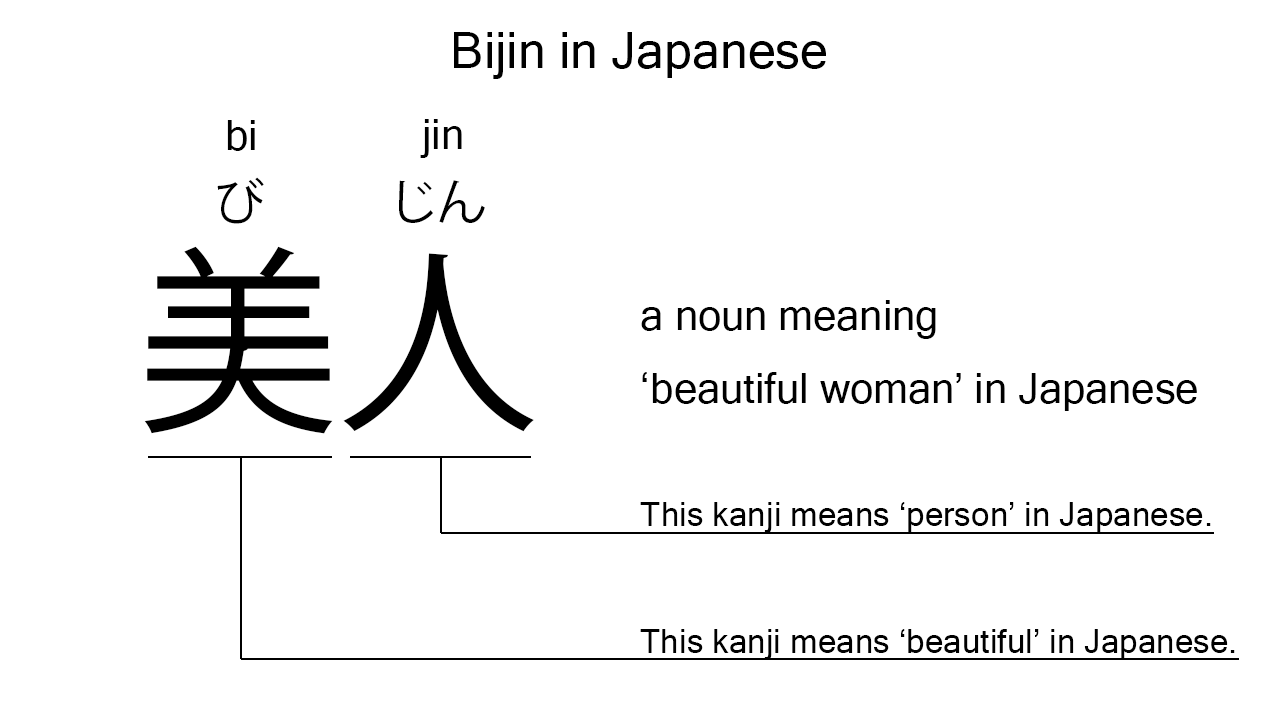What does “bijin” mean in Japanese?
Native speakers say “bijin” to mean ‘beautiful woman’ in Japanese. Perhaps, some Japanese learners know this word as it is sometimes used in Japanese movies, songs, novels, manga, anime, and the like. In this blog post, however, I will explain this word in detail based on its kanji expression. And also, I will explain how to use it through example sentences. My explanations would help Japanese learners understand “bijin” more clearly. Then, let’s get started!
Contents
Definition and meaning of “bijin”
Let me start with the definition and meaning of “bijin”.
- bijin – 美人 (びじん) : a noun meaning ‘beautiful woman’ in Japanese. This can also work as plural. Learn more about Japanese plural.
Native speakers use this noun to refer to a beautiful person, especially a beautiful woman in Japanese.
The definition and meaning are simple and clear. To understand this noun more clearly, however, let me explain its kanji characters in detail, one by one.
What does “bijin” literally mean in Japanese?
The kanji expression of “bijin” consists of the following two kanji characters:
- 美 : a kanji character widely used to mean ‘beautiful’ in Japanese.
- 人 : a kanji character widely used to mean ‘person’ in Japanese.
These two kanji characters tell us that the formed noun literally means a ‘beautiful person’ in Japanese. This literal interpretation is close to the actual meaning.

When we meet new kanji expressions, we should check their kanji characters in detail to understand their meanings clearly and deeply. In many cases, kanji characters tell us a lot about the meanings of the expressions they form. Actually, here, we could get the better understanding of “bijin” through the detailed kanji check above.
So far, I’ve explained the definition and meaning of “bijin” together with its kanji characters. Then, let me explain how to use it through the example sentences below.
Example #1: how to say “beautiful woman” in Japanese
watashi no musume wa bijin desu – 私の娘は美人です (わたしのむすめはびじんです)
My daughter is a beautiful woman.
Below are the new words used in the example sentence.
- watashi – 私 (わたし) : a pronoun meaning ‘I’ in Japanese.
- no – の : a case particle used after a noun or pronoun to make its possessive case. In the example, this is used after “watashi” to make its possessive case, “watashi no“, which means ‘my’ in Japanese.
- musume – 娘 (むすめ) : a noun meaning ‘daughter’ in Japanese. This can also work as plural.
- wa – は : a binding particle working as a case marker or topic marker. In the example, this works after “watashi no musume” to make the subject in the sentence.
- desu – です : an auxiliary verb used after a noun or adjective to make it polite. Probably, this is well known as a part of Japanese desu form. In the example, this is used after “bijin” to make it sound polite.
This is a typical usage of “bijin”. In this example, it works as the complement in the sentence.
Example #2: another usage of “bijin”
kanojo wa bijin ga suki desu – 彼女は美人が好きです (かのじょはびじんがすきです)
She loves beautiful women.
Below are the new words used in the example sentence.
- kanojo – 彼女 (かのじょ) : a pronoun meaning ‘she’ in Japanese.
- ga – が : a case particle used to make the subject word or the object word in a sentence. In the example, this is used after “bijin” to make the object in the sentence.
- suki – 好き (すき) : the stem part of the na-adjective, “sukina”, which means ‘favorite’ in Japanese. Native speakers, however, often use this as an individual word to mean ‘to like’ or ‘to love’ in Japanese. In the example, this is used to mean ‘to love’.
This is another typical usage of “bijin”. In this example, it works as plural to mean ‘beautiful women’ in Japanese. When we want to refer to a beautiful woman or women in Japanese, anyway, this noun is always a very good option.
Summary
In this blog post, I’ve explained the definition and meaning of “bijin” in detail based on its kanji expression. And also, I’ve explained how to use it through the example sentences. Let me summarize them as follows.
- bijin – 美人 (びじん) : a noun meaning ‘beautiful woman’ in Japanese. This can also work as plural. These two kanji characters literally mean a ‘beautiful person’ in Japanese. This literal interpretation is close to the actual meaning. Indeed, native speakers use this noun to refer to a beautiful person, especially a beautiful woman in Japanese.
Hope my explanations are understandable and helpful for Japanese learners.